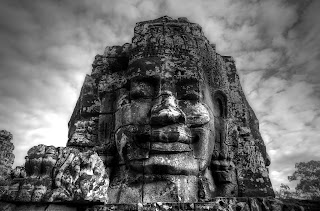Angkor Thom (Great City) is my personal favourite place. This is not simply a temple but a city of temples which formed the last and largest capital of the mighty Khmer Empire. The surrounding Gates and Motes of the city alone would swallow up any Cathedral in Europe. As soon as you enter the South Gate you realise the sheer size of the place and it it hard to fathom what the city must have looked like when it was home to over 1 Million people when London was merely 40000!!!! It was established in the late twelfth century by king Jayavaraman VII. It covers an area of over 10 km², within which are located several monuments from earlier eras as well as those established by Jayavarman and his successors. At the centre of the city is Jayavarman's state temple, the Bayon, with the other major sites clustered around the Victory Square immediately to the north. Bayon is my all time favourite temple with its fascinating 216, 2 meter high faces carved in the towers of the temple.
Angkor Thom was established as the capital of Jayavarman VII's empire, and was the centre of his massive building programme. One inscription found in the city refers to Jayavarman as the groom and the city as his bride.
Angkor Thom seems not to be the first Khmer capital on the site, however. Yasodharapura, dating from three centuries earlier, was centred slightly further northwest, and Angkor Thom overlapped parts of it. The most notable earlier temples within the city are the former state temple of Baphuon, and Phimeanakas, which was incorporated into the Royal Palace. The Khmers did not draw any clear distinctions between Angkor Thom and Yashodharapura: even in the fourteenth century an inscription used the earlier name. (Higham 138) The name of Angkor Thom — great city — was in use from the 16th century.





















No comments:
Post a Comment